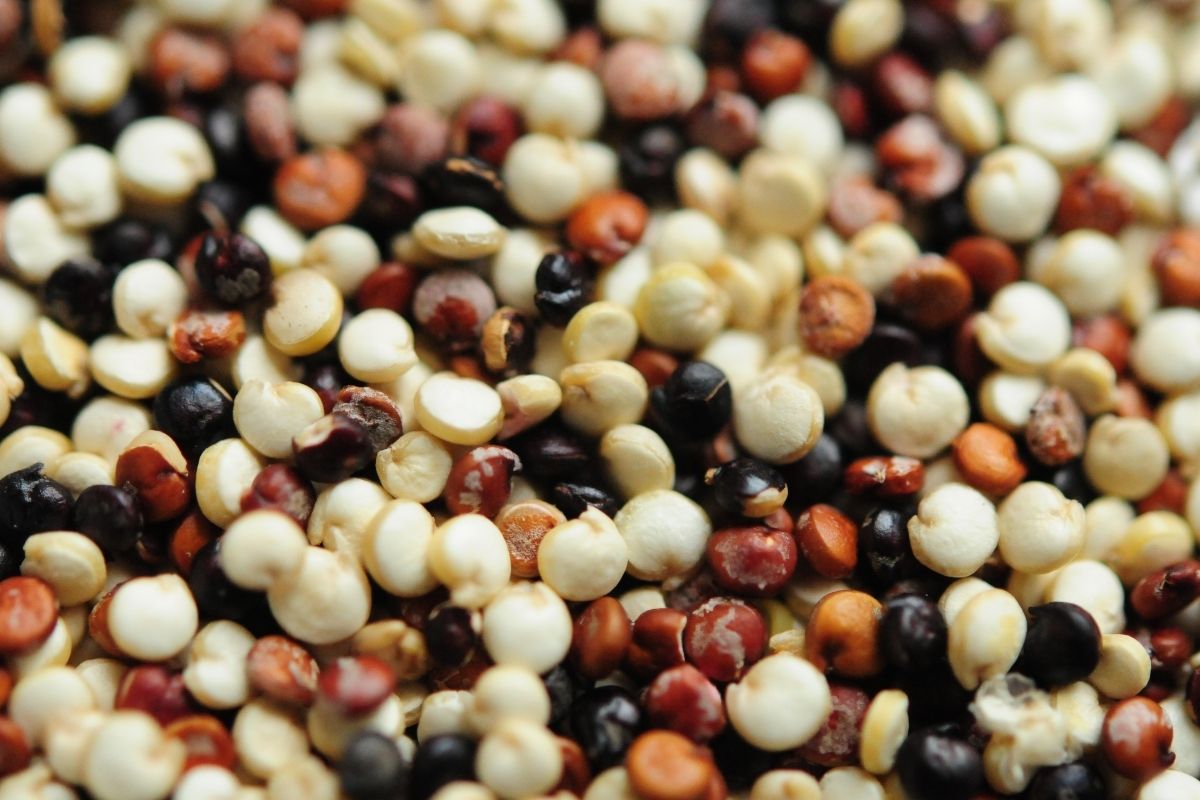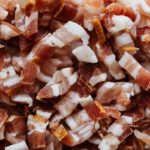If you’re looking for alternatives to many popular, gluten-rich grains such as wheat, rye and barley, you may find yourself asking: Is quinoa gluten-free?
Well, the short answer is Yes. However, to find out why this is makes it a valuable addition to many people suffering from gluten-intolerance, read on.
The Problem with Gluten
Non-coeliac (celiac) gluten-sensitive people experience many of the same gastrointestinal symptoms as those who have coeliac disease. However, researchers do not know why this happens.
Some believe that gluten may be triggering an autoimmune reaction. People with non-coeliac gluten intolerance can also suffer from neurological disorders.

If you are sensitive to gluten, even just slightly, it’s wise to follow a gluten-free diet.
Thankfully, with more and more people developing gluten intolerances, there are a plethora of GF products available. This means you won’t feel like you’re missing out.
Like to bake but struggling to find a Grain Free Pastry Recipe? Read this.
There are many super healthy foods that are naturally gluten-free and are well worth investigating and experimenting with.
Quinoa is an ancient grain that was cultivated by the Inca people centuries ago.
For a huge range of Quinoa Based Products – including Grains, Flakes, Flour and Pastas – click here.
Today, quinoa is gaining popularity as a healthy alternative to wheat. It is rich in protein, fibre, iron, calcium, magnesium, phosphorus, zinc, and vitamins B6, E, K, and C.
Getting bored of the same old breakfast? Try our Paleo and Grain Free Porridge Recipes
Quinoa is technically not a grain but a seed from the Chenopodium quinoa plant.
It is considered a whole grain and is a pseudo-cereal because it doesn’t grow naturally in a field or a farm.
And that all important question: Is Quinoa Gluten Free?
The good news is that it is gluten-free, making it a great alternative for those who suffer from celiac disease or gluten intolerance.
It also contains more iron than spinach and other leafy greens. Furthermore, It is low in fat and sodium.
You can cook quinoa as you would rice or pasta. It is available in many different varieties, including red, black, white, and multi-coloured.
Love pasta but find most brands turn to mush when cooked? See our post, Gluten Free Pasta (is it worth it?) – A User Review
History
Quinoa is native to South America. It was traditionally used by several indigenous people, including the Quechuan, Aymaran, Tiawanco, Chibcha, Mapuche, and other tribes.
In Peru, quinoa is known as chisaya, and in Bolivia, it is called kaweña.
Over the years the seeds have been consumed in a similar way to rice, prepared in soups, puffed to make breakfasts, or ground into flour for cookies, bread, biscuits and noodles.
Quinoa leaves have also been eaten like spinach, and the germinated seeds have been added to salads. It can also be eaten raw.
Quinoa sprouts can even be fermented to make alcohol or a traditional drink from South America called ‘Chicha’.
The whole plant has also fed livestock, including cows, pigs, and poultry.
Are you partial to a Savoury Muffin? Try our Gluten Free Recipes
Different Types
There are many kinds of quinoa, but the most popular ones are white, red, and black.
White quinoa has a fluffy texture, red quinoa keeps its shape better when cooked, and black quinoa is crunchy.
Beware
Whilst quinoa is naturally gluten-free, it isn’t quite as simple as that. This is because it contains prolamins, which may cause problems for some people with coeliac disease.
Eating 1.8 ounces of quinoa per day is safe and usually well-tolerated but caution is advised.
In addition, although quinoa is technically gluten-free, the processing may be done in facilities that handle wheat or barley. As a result, cross-contamination can be a problem.
In particular, pregnant women should talk to their doctors about consuming quinoa because there isn’t enough evidence about how it affects them.
We have some great Gluten Free Grain Free Scone Recipes for you
Digestion
Quinoa can sometimes have a bitter taste and has a residue on it called saponin. This residue can sometimes cause stomach upsets so it’s important to clean the grain thoroughly before consumption as this may reduce the risk.
So if you can tolerate quinoa and want to incorporate it into your diet, what should you know?
Sometimes, eating a diverse range of foods can be hard. See our article, Achieving Food Variety (Whilst Remaining Gluten-Free)
Benefits

Quinoa is considered a complete source of proteins and is very healthy. It contains antioxidants and may help prevent cancer. What exactly are antioxidants?
Antioxidants are chemicals in fruits and vegetables that help fight off free radicals. They prevent damage to cells and DNA. This means they can stop or slow down the ageing process. Importantly, they can also protect you from diseases such as cancer and heart disease.
Free radicals are dangerous chemicals produced by cells. They can harm DNA and other molecules inside our bodies.
Unfortunately, we produce them naturally when we metabolise oxygen.
What’s more, we make more than we need, and too many free radicals can lead to cancer, heart disease, and other problems.
So how can we protect ourselves?
Well, eating food rich in antioxidants helps and, of course, such as quinoa is one such food.
Quinoa is also an excellent source of manganese, magnesium and phosphorus. A cup of cooked quinoa provides approximately 185 grams of carbohydrates.
Another plus for quinoa is that ii contains more than twice the amount of protein found in most other grains.
Its rich fibre content makes it a great alternative to wheat products and it may be beneficial to those who suffer from digestive disorders.
As mentioned, quinoa is also a great source of magnesium. And Magnesium deficiency is commonly associated with type II diabetes.
Magnesium-rich foods such as quinoa can help prevent strokes. In addition, eating quinoa regularly helps improve heart health.
Better Than Rice?
Quinoa definitely wins the ‘healthiest’ contest with rice because quinoa has more fibre and protein.
People who eat quinoa feel full longer and feel less hungry afterwards compared to those who eat rice.
Having said that, rice is less likely to give you intestinal upset so is a good alternative to quinoa if you struggle with digestive issues.
Do you have a weakness for chocolate? Then our Gluten-Free Chocolate Chia Cake Recipes are for you.
Weight Loss
Whilst Quinoa is packed with the good stuff, unfortunately it is not considered a low-calorie food.
One cup of plain, cooked quinoa is about 222 calories, so it’s important to consume in small amounts if you are following a calorie-controlled diet.
Are breakfasts dull in your house? See our Paleo and Grain Free Porridge Recipes
Cooking
You can eat quinoa as a side dish, or use it in salads and soups. It’s also great for baking because it doesn’t need any leavening agents.
To cook quinoa, boil 1 cup of water in a medium saucepan over high heat. Add the rinsed quinoa and stir frequently.
Cover the pan and reduce the heat to low. Cook for 12 to 14 minutes, stirring occasionally.
When the liquid is absorbed, remove the lid and fluff the grains with a fork. Serve hot or cold.
Quinoa needs more than 12 minutes to cook because it takes longer to absorb the liquid than other grains.
When it’s cooked, it should be fluffy and soft inside. Generally, It doesn’t need any salt added.
Alternatives
If you find you can’t tolerate quinoa, what alternatives are available?
- Brown rice is naturally gluten-free as well as brown rice and quinoa blends. Wild and black rice is also gluten-free providing a healthy alternative to plain quinoa.
- Chickpeas are much bigger than other legumes, but they’re a great choice if you want something quick, gluten-free, and with a similar protein/fibre content to quinoa.
- Millet is a whole grain that is gluten-free. It can be fluffy or creamy depending on how much water you put into it. It is also a complete protein and healthy because of its high magnesium content. You can cook millet in many different ways.
In Summary
Quinoa has been consumed for centuries and is a substantial and healthy complete grain.
It makes a great addition to a gluten-free diet and is versatile and tasty. Happy cooking!
- Bouvardia – Our Review - April 23, 2024
- Pomelo Rooftop Bar - April 23, 2024
- Haiku Melbourne - April 23, 2024








